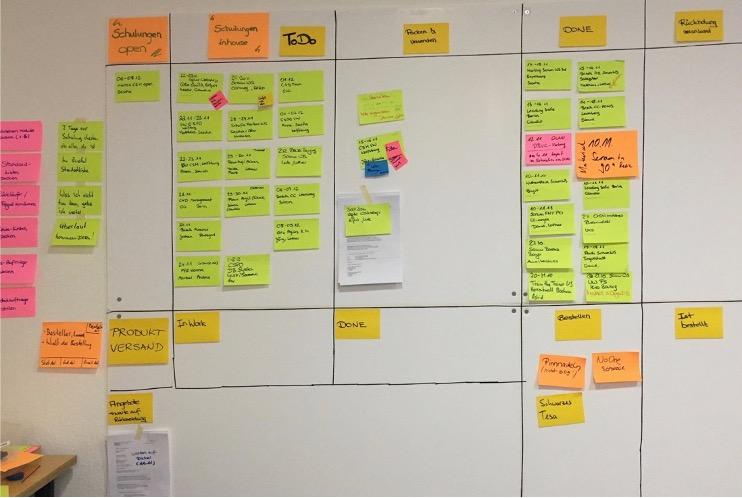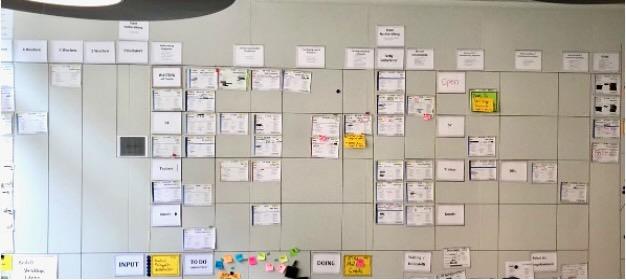Success Story
Kanban Service Team - a development journey
I would like to take you on the development journey of our "Service Team", how it turned a "To Do List" into a Kanban Board and how we have built a self-organized Kanban service team with changing staffing. You can take away ideas on how to develop a self-organized team, how to introduce Kanban in an evolutionary way, how to deal with dependencies and deadlines and how to successfully face a changing team. - Julia Stiegelmayer.
How the Kanban Service Team development journey began
For each training we conduct at wibas, our trainers need the right training material. This varies depending on the training and needs to be on site on time in the different companies and locations where training takes place. In the past, our colleagues in the office did this job. However, our goal was to transfer this activity to a self-organized working student team. This was the starting point for our service team.
 The service team started with 5 working students (3 of them were brand new to the company) and a simple "To Do" board.
The service team started with 5 working students (3 of them were brand new to the company) and a simple "To Do" board.
Here you can see the Kanban board from 2016.
Over 3 years, the team has developed into a self-organized Kanban team of a total of 9 working students from various disciplines.
Over time, the team has taken on additional services and further developed its kanban board. Here you can see the status of 2019, when the kanban board already looked much more complex. It also included a more advanced layout of the individual work items.
How did the Kanban Service Team solve its challenges with Kanban?
Julia had joined the team as Agility Master with the team. In the following video, she tells you how the team dealt with various challenges and how Kanban helped.
The challenges of the Kanban Service Team
At the outset, the service team faced a number of challenges that needed to be overcome. One key issue was that the work was not completed on time. In addition, follow-up was often neglected. This resulted in delays and compromised service quality. Good visualization of the work also proved difficult.
The attempt to map every work step resulted in a board with 16 (!) columns. The hoped-for better overview did not materialize. With the new board, it was now difficult to keep a clear overview of the ongoing tasks. The multitude of urgent tasks the team was faced with exacerbated the stress level. Due to the time-bound tasks, it seemed impossible for the team to get out of the driven push system into a pull system to change. It became clear that a new approach was needed to address these challenges and change the way the Service teams to improve.
How did we go about it? Our approach.
The collaboration with the service team began with a clear starting point: a simple to-do board. From this point, we worked together to make incremental and continuous improvements. To support this process, we introduced a weekly "Kaizen" meeting based on the Japanese concept of continuous improvement. In these meetings, the Agility Master and the team conducted regular Retrospectives through. Current challenges faced by the team were analyzed at these meetings. These discussions resulted in various measures to improve the work processes, sometimes in the form of adjustments to the board itself. Over time, the content of the kaizen changed as the team matured and faced new challenges.
Specific issues we have addressed with the team:
- How do we get from a push to a pull system?
- Where are our bottlenecks?
- How can we make the system sustainable for service team members?
Solutions that have emerged from these questions:
- By introducing work-in-progress (WIP) limits, the team started fewer tasks in parallel. This created a natural focus on finishing work.
- Bottlenecks due to external dependencies became visible through the WIP limits.
A capacity bottleneck could be identified, which was concealed by overtime for a long time. - This was made transparent in the team and leads to the prioritization of service classes as well as the expansion of the team.
The team was empowered to solve problems in a self-organized way. This includes a self-organized recruiting, change of suppliers or process adjustments.
Our contribution - impact and positive effects
By introducing the Kaizen meeting, we raised awareness of continuous improvement within the team and encouraged the team to conduct regular experiments. Together, we adapted processes and the Kanban board to meet the specific needs of the team and eliminate bottlenecks. An important component was coaching the team as well as individual team members. In the process, the team Passing through the ""Forming", "Storming" and "Norming" phase. In this context, we supported the respective phase by providing appropriate guidance in order to promote effective cooperation. In addition, we also promoted organizational collaboration. This led to better exchange and cooperation between the teams. This comprehensive support has helped the service team to work more efficiently and successfully master challenging tasks, and to continue to develop.
Today - 2023 - the service team is responsible for essential parts of the value creation and is an integral and professional part of the organization.
Julia Stiegelmayer is now an accredited kanban trainer and is happy to share her experience. For support in setting up or further developing kanban teams, Julia is happy to help.
Strategy development at E-T-A
Success Story: E-T-A and wibas design a participative and agile strategy process. Read why this was good.
Agile product development at Merck KGaA
Success Story: wibas supports a team of the company Merck KgaA. Learn here how we established a strategic agile product development and why it was good.
Kanban in a nutshell: impulses to frequently asked questions
Whether you have just started your own team, are fresh from Scrum training or have been at it for a while: Sooner or later [...]
Kanban Trainings
With us you learn to do Kanban yourself and better - with certified trainings from Kanban University.
10 Ways to Drive Your Kanban System to the Wall
As a coach, trainer and consultant, I frequently come across teams that are having challenges getting their Kanban system up and running [...]
Your contact person:
Julia Stiegelmayer
wibas GmbH
Julia Stiegelmayer
Otto-Hesse-Str. 19B
64293 Darmstadt

